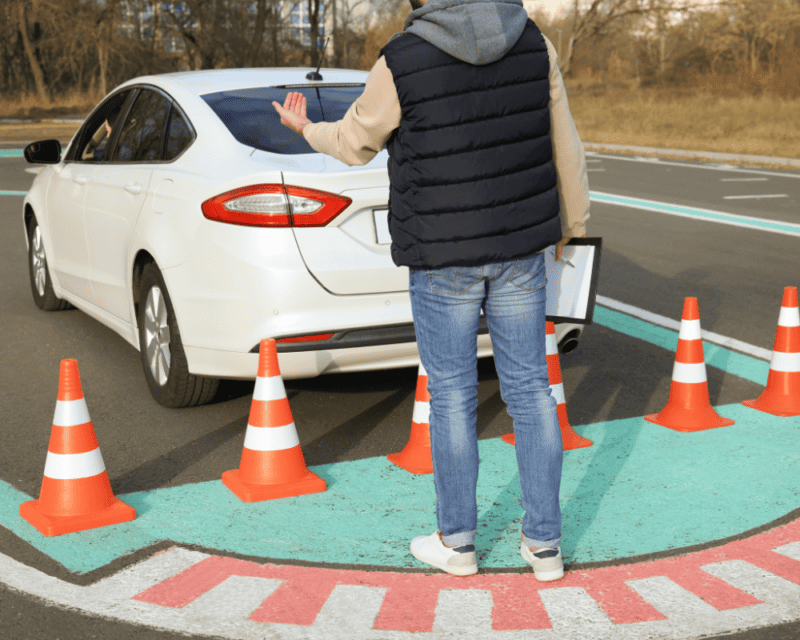As the DVSA prepares to unveil the latest driving test statistics for the period spanning April 2023 to March 2024, Regtransfers, a specialist in personalised number plates, engaged in a conversation with Sophie Stuchfield, a seasoned driving instructor with fifteen years of experience in teaching and providing driving test advice on social media via the handle @TheOnlineDrivingInstructor. Together, they delve into the top 10 mistakes observed in UK driving tests over the past ten years.
1. Observation at Junctions

Sophie stresses the importance of vigilant observation at junctions – the most frequent area of fault during driving tests over the past decade. “If you don’t pay close attention to road markings or road signs, you may be completely unaware that you are approaching a junction”, she warns.
What might this lead to? “In this instance,” comments Sophie, “an examiner may have to either verbally warn you or apply the dual control brake pedal to slow down/stop”. She also stresses the importance of double checking when emerging from a junction: “only looking once is never enough, you must double check when emerging to make sure the road is safe.”
2. Mirrors – (change direction)
Ensuring mirrors are checked before signalling, changing direction, or altering speed is a fundamental skill that all learner drivers must master, and the “Mirror-Signal-Manoeuvre” routine should become second nature in every new driver. Potential mistakes in this area include, among others, delayed or missed use of mirrors before changing direction.
On this subject, Sophie reaffirms the importance of this practice, particularly with regard to wing mirrors when switching lanes or navigating hazards. “Before you move right, check your right-wing mirror. Before you move left, check your left wing mirror. It’s something which seems very simple and obvious, but it’s amazing how many people forget this,” she remarks.
She attributes this common lapse to nervousness, explaining that learners often overthink during their test, preoccupied with concerns about how they might be evaluated by the instructor, rather than reacting naturally to hazards.
3. Junctions (turning right)
When making right turns at junctions, Sophie advises caution, stating, “You must not cut the corner when turning into a road on your right. Even if the junction is completely clear of other road users, you must use correct positioning at all times.”
She further explains the importance of learner drivers taking up proper positioning on the road: “Approaching the turn, if there is no oncoming traffic, drivers will often drift to the wrong side of the road before turning. It’s really important to stay on your side of the road until you reach your point of turn.”
4. Control (steering)

It’s commonly accepted that errors made by learners during their tests often stem from understandable anxiety. “When nervous, our bodies tend to tense up”, says Sophie. “Combine this with the fact most drivers incorrectly believe that we are not allowed to cross arms, and suddenly steering becomes stiff – which leads to understeering with an uncomfortable and ineffective shuffling of hands on the wheel.”
Surprisingly, crossing arms on the steering wheel is not grounds for test failure, Sophie clarifies, and many instructors (herself included) advocate for flexibility in steering techniques as long as they ensure safety. “As long as you maintain control of the vehicle, it is perfectly acceptable to cross your arms. Sometimes, it’s even necessary to perform lots of steering in a quick moment.”
5. Response to signals (traffic lights)
Sophie provides practical advice for reacting to traffic signals: “While waiting at a red light, remain focussed to avoid missing the transition to green. This might seem like simple advice, but drivers – not just learners – can allow their thoughts to wander. Before you know it, the vehicle behind you is honking, the light has turned green, and you’re left feeling embarrassed! In a test situation, this can make your nerves worse.”
She also stresses the significance of anticipation: “You must not cross the stop line when the light is amber. When approaching traffic lights that have been green for an extended period, it is always best to anticipate that they might change”.
6. Move off (safely)
During driving tests, candidates will be instructed to stop on the left at least four times.
Subsequently, they will be assessed on their ability to move off safely from the roadside, including their observations, ability to avoid inconveniencing other road users and allow ample clearance for parked vehicles.
Offering advice in this area of the test, Sophie states, “Take your time to make sure you have the correct gear selected, the handbrake is down, and you complete the six-point check to ensure your surroundings are safe before moving.” She insists on the importance of not rushing and ensuring safety: “You must not cause any other cars to slow down. Wait until you have a safe gap!”
7. Positioning (normal driving)
For regular driving positioning, Sophie provides straightforward guidance: “Do not use the right-hand lane unless you are overtaking or turning right. If you’re an international driver who is used to driving on the right, make sure you get enough practice driving on the left, so it feels more natural and normal to you.”
8. Move off (control)

Similar to moving off safely, maintaining control during the process requires thorough observation, merging onto a new road without impeding other road users, and ensuring ample distance from parked vehicles.
Regarding control during the move-off phase, Sophie reiterates the impact of nerves and the need for a cool head: “As mentioned earlier, when moving off, it’s important to take your time and make sure you have the correct gear selected. If you stall while driving a manual, take a moment to catch your breath(!) before getting started again; stalling isn’t an automatic fail”.
9. Response to Signals (Road Markings)
Throughout a test, the examiner evaluates the candidate’s appropriate responses to all road lines and lane markings, stop and giveway lines, box junctions, and traffic calming measures. Faults include driving in bus lanes, not stopping at stop markings, and stopping in “keep clear” zones.
“Always read the road”, comments Sophie. “This means keeping an eye out in advance for any arrows, which will help you to select the correct lane for your direction at all times.” She also advises that if road markings (or signs) are poor, an examiner will direct test candidates. “Remember, you can always ask for clarification if you need it, provided you ask in plenty of time.”
10. Reverse Park (Control)

During parking manoeuvres, candidates must choose a suitable parking space, position the vehicle accurately, prepare for the reverse, and maintain awareness of their surroundings both before and during the manoeuvre. Parking should be executed with precision, control, and an awareness of the environment.
“Take your time when parking”, comments Sophie. “You can make adjustments, dip door mirrors, open windows to see and even get out and check that your position is correct.”
Conclusion
In addition to the aforementioned list, Sophie acknowledges two other common reasons for learner drivers failing their tests:
“In my opinion, people fail their test due to one of two reasons: nerves or taking their test too soon. If you’re learning to drive, it’s important to be relaxed, focused and comfortable during your driving test – just as you would be if you were driving on any other day. As for the second point, don’t be in a rush to get your licence. Take your time with lessons and make sure you and your instructor both feel you’re ready and able to pass.”
